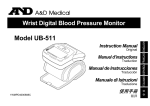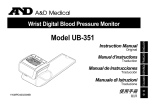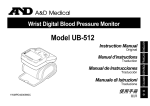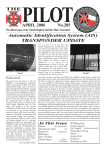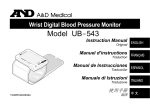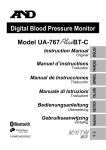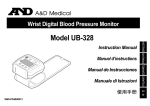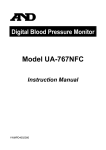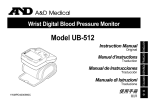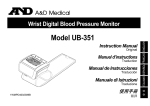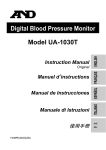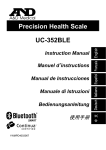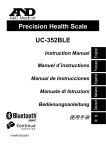Download A&D UB-510 Technical data
Transcript
Wrist Digital Blood Pressure Monitor Model UB-510 1WMPD4001955A Contents Dear Customers............................................................................................................................................. 1 Preliminary Remarks ..................................................................................................................................... 1 Precautions.................................................................................................................................................... 1 Parts Identification ......................................................................................................................................... 3 Symbols ......................................................................................................................................................... 4 Using the Monitor........................................................................................................................................... 5 1. Installing / Changing the Batteries........................................................................................................ 5 2. Fastening the Cuff ................................................................................................................................ 6 3. How to Take Proper Measurements..................................................................................................... 7 4. Measurement ....................................................................................................................................... 7 5. After Measurement............................................................................................................................... 7 Measurements ............................................................................................................................................... 8 Normal Measurement............................................................................................................................... 8 Notes For Proper Measurement............................................................................................................... 9 Operation Mode ....................................................................................................................................... 9 What Is An Irregular Heartbeat? .................................................................................................................. 10 Pressure Bar Indicator ................................................................................................................................. 10 WHO Classification Indicator ....................................................................................................................... 11 About Blood Pressure.................................................................................................................................. 11 What Is Blood Pressure? ....................................................................................................................... 11 What Is Hypertension And How Is It Controlled? ................................................................................... 11 Why Measure Blood Pressure At Home?............................................................................................... 12 WHO Blood Pressure Classification....................................................................................................... 12 Blood Pressure Variations...................................................................................................................... 12 Troubleshooting ........................................................................................................................................... 13 Maintenance ................................................................................................................................................ 14 Technical Data............................................................................................................................................. 14 Dear Customers Congratulations on purchasing a state-of-the-art A&D blood pressure monitor, one of the most advanced monitors available today. Designed for ease of use and accuracy, this monitor will facilitate your daily blood pressure regimen. We recommend that you read through this manual carefully before using the device for the first time. Preliminary Remarks This device conforms to the European Directive 93/42 EEC for Medical Products. This is made evident by the mark of conformity. (0123: The reference number to the involved notified body) The device is designed for use on adults only, not newborns or infants. Environment for use The device is for use in the home healthcare environment. This device is designed to measure blood pressure and pulse rate of people for diagnosis. Precautions Precision components are used in the construction of this device. Extremes in temperature, humidity, direct sunlight, shock or dust should be avoided. Clean the device and cuff with a dry, soft cloth or a cloth dampened with water and a neutral detergent. Never use alcohol, benzene, thinner or other harsh chemicals to clean the device or cuff. Avoid tightly folding the cuff for long periods, as such treatment may shorten the life of the components. The device and cuff are not water resistant. Prevent rain, sweat and water from soiling the device and cuff. Measurements may be distorted if the device is used close to televisions, microwave ovens, cellular telephones, X-ray or other devices with strong electrical fields. 1 Used equipment, parts and batteries are not treated as ordinary household waste, and must be disposed of according to the applicable local regulations. When reusing the device, confirm that the device is clean. Do not modify the device. It may cause accidents or damage to the device. To measure blood pressure, the wrist must be squeezed by the cuff hard enough to temporarily stop blood flow through the artery. This may cause pain, numbness or a temporary red mark to the wrist. This condition will appear especially when measurement is repeated successively. Any pain, numbness, or red marks will disappear with time. Contraindications The following are precautions for proper use of the device. Do not apply the cuff to an arm with another medical electrical equipment attached. The equipment may not function properly. People who have a severe circulatory deficit in the arm must consult a doctor before using the device, to avoid medical problems. Do not self-diagnose the measurement results and start treatment by yourself. Always consult your doctor for evaluation of the results and treatment. Do not apply the cuff on an arm with an unhealed wound. Do not apply the cuff on an arm receiving an intravenous drip or blood transfusion. It may cause injury or accidents. Do not use the device where flammable gases such as anesthetic gases are present. It may cause an explosion. Do not use the device in highly concentrated oxygen environments, such as a high-pressure oxygen chamber or an oxygen tent. It may cause a fire or explosion. 2 Parts Identification 3 Symbols Symbols Function / Meaning Recommended Action Standby and Turn the device on Battery installation guide Direct current SN Serial number Date of manufacture Type BF: Device, cuff and tubing are designed to provide special protection against electrical shocks. Measurement is in progress. Remain as still as The indicator that appears while measurement is in progress. It blinks when the pulse is detected. possible. Irregular Heartbeat indicator. (I.H.B.) The indicator that appears when an irregular heartbeat or any excessive body movement is detected during the measurement. Previous measurements stored in MEMORY. Full Battery The battery power indicator during measurement. Replace both batteries with new ones when the low Battery The battery is low when it blinks. indicator blinks. Unstable blood pressure due to movement during the Try the measurement again. measurement. Remain very still during the measurement. The systolic and diastolic values are within 10 mmHg of each other. Fasten the cuff correctly, and try the The pressure value did not increase during inflation. measurement again. The cuff is not fastened correctly. The pulse is not detected correctly. SYS Systolic blood pressure in mmHg DIA Diastolic blood pressure in mmHg. 4 Symbols PUL./min Function / Meaning Recommended Action Pulse per minute EC directive medical device label WEEE label Manufacturer EU-representative Refer to instruction manual/booklet Using the Monitor 1. Installing / Changing the Batteries 1. Slide the battery cover as shown to remove it from the device. 2. Insert two AAA / LR03 size batteries in the battery compartment, with positive (+) and negative (-) terminals matching those indicated on the battery compartment. 3. Slide the battery cover back on the device. • Insert the batteries as shown on the battery compartment. If not, the device will not work. • When (LOW BATTERY mark) appears in the display, replace both batteries with new ones at the same time. Do not mix old and new batteries. It may cause the battery life to be shortened, or the device to malfunction. 5 • (LOW BATTERY mark) does not appear when the batteries are drained. • Battery life varies with ambient temperature and may be shorter at low temperatures. • Remove batteries if the device is not to be used for a long period of time. The batteries may leak and cause a malfunction. • Use the specified batteries only. The batteries provided with the device are for testing the monitor performance and may have a shorter life. 2. Fastening the Cuff 1. Wrap the cuff around your wrist about 1 cm above your hand as shown in the figure at the right. 2. Fasten the cuff tightly using the Velcro strip. Note: For proper measurements, fasten the cuff tightly and measure on a bare wrist. 6 3. How to Take Proper Measurements For best accuracy in blood pressure measurement: • Sit comfortably at a table. Rest your arm on the table. • Relax for about 5 to 10 minutes before measurement. • Raise your hand so that the cuff is at the same level as your heart. • Remain still and keep quiet during measurement. • Do not measure right after physical exercise or a bath. We recommend you to rest 20 or 30 minutes before taking measurement. • Measure your blood pressure at about the same time every day. 4. Measurement During measurement, it is normal for the cuff to feel very tight. (Do not be alarmed.) 5. After Measurement After measurement, press the START button to turn off the power. Remove the cuff and record your data. Note: The device is provided with an automatic power shut-off function which turns off the power automatically one minute after measurement. Allow at least ten minutes between measurements on the same person. 7 Measurements Note: The UB-510, once used, will provide an inflation appropriate to the user, based on the previous measurement. Normal Measurement 1. Sit comfortably with the cuff at the same level as your heart and relax. 2. Press the START button. The average recorded blood pressures and data number are displayed briefly. Then the display changes as indicated in the figure on the right as measurement begins. The cuff starts to inflate. It is normal for the cuff to feel very tight. Note: If you wish to stop inflation at any time, press the START button again. 3. The measurement starts automatically when pressurizing starts, and the (heart mark) blinks. 4. When measurement is complete, the systolic and diastolic pressure readings and pulse rate are displayed. The cuff exhausts the remaining air and completely deflates automatically. 5. Press the START button again to turn off the power. Remove the cuff. Note: The device is provided with an automatic power shut-off function. Allow at least ten minutes between measurements on the same person. 8 Notes For Proper Measurement Sit down in a comfortable position. Place the arm to be used for the measurement on a table or other support so that the center of the cuff will be at the same height as your heart. Relax for about five or ten minutes before taking a measurement. If you are excited or depressed by emotional stress, the measurement will reflect this stress as a higher (or lower) than normal blood pressure reading and the pulse reading will usually be faster than normal. An individual's blood pressure varies constantly, depending on what they are doing and what they have eaten. What you drink can have a very strong and rapid effect on your blood pressure. This device bases its measurements on the heartbeat. If you have a very weak or irregular heartbeat, the device may have difficulty determining your blood pressure. Should the device detect a condition that is abnormal, it will stop the measurement and display an error symbol. See pages 3 and 4 for the description of symbols. This blood pressure monitor is intended for use by adults only. Consult with your physician before using this device on a child. A child should not use this device unattended. Operation Mode 1. Normal measurement with storing data (Refer to page 8) Press the START button. Blood pressure is measured and data is stored within the device. The device can store the last thirty sets of data. 2. Recalling data Press and hold the START button to recall the data. Stored data are automatically displayed in order from the last data. 3. Clearing data Remove batteries to clear all data. Re-install them again. 9 What Is An Irregular Heartbeat? Model UB-510 blood pressure monitor provides a blood pressure and pulse rate measurement even when an irregular heartbeat occurs. An irregular heartbeat is defined as a heartbeat that varies by 25% from the average of all heartbeats during the blood pressure measurement. It is important that you be relaxed, remain still and do not talk during measurements. Note: We recommend contacting your physician if you see this indicator frequently. Pressure Bar Indicator The indicator monitors the progress of pressure during measurement. 10 WHO Classification Indicator Each six segments of the bar indicator correspond to the WHO blood pressure classification described on the next page. Example WHO Classification Indicator Severe hypertension Mild Moderate High normal hypertension hypertension Moderate hypertension Mild hypertension High normal Normal Optimal : The indicator displays a segment, based on the current data, corresponding to the WHO classification. About Blood Pressure What Is Blood Pressure? Blood pressure is the force exerted by blood against the walls of the arteries. Systolic pressure occurs when the heart contracts. Diastolic pressure occurs when the heart expands. Blood pressure is measured in millimeters of mercury (mmHg). One's natural blood pressure is represented by the fundamental pressure, which is measured first thing in the morning while one is still at rest and before eating. What Is Hypertension And How Is It Controlled? Hypertension, an abnormally high arterial blood pressure, if left unattended can cause many health problems including stroke and heart attack. Hypertension can be controlled by altering lifestyle, avoiding stress, and with medication under a doctor’s supervision. 11 To prevent hypertension or keep it under control: Do not smoke Exercise regularly Reduce salt and fat intake Have regular physical checkups Maintain proper weight Why Measure Blood Pressure At Home? Blood pressure measured at a clinic or doctor's office may cause apprehension and can produce an elevated reading, 25 to 30 mmHg higher than that measured at home. Home measurement reduces the effects of outside influences on blood pressure readings, supplements the doctor's readings and provides a more accurate, complete blood pressure history. WHO Blood Pressure Classification Standards to assess high blood pressure, without regard to age, have been established by the World Health Organization (WHO), as shown in the chart on the right. Blood Pressure Variations An individual’s blood pressure varies greatly on a daily and seasonal basis. It may vary by 30 to 50 mmHg due to various conditions during the day. In hypertensive individuals variations are even more pronounced. Normally, the blood pressure rises while at work or play and falls to its lowest levels during sleep. So, do not be overly concerned by the results of one measurement. Take measurements at the same time every day using the procedure described in this manual to get to know your normal blood pressure. Regular readings give a more comprehensive blood pressure history. Be sure to note the date and time when recording your blood pressure. Consult your doctor to interpret your blood pressure data. 12 Troubleshooting Problem Possible Reason Batteries are drained. Nothing appears in the display, even when the Battery terminals are not in the correct power is turned on. position. The cuff does not inflate. The device does not measure. Readings are too high or too low. Other Battery voltage is too low. (LOW BATTERY mark) blinks. [ If the batteries are drained completely, the mark does not appear.] The cuff is not fastened properly. You moved your arm or body during the measurement. Recommended Action Replace both batteries with new ones. Reinstall the batteries with negative and positive terminals matching those indicated on the battery compartment. Replace both batteries with new ones. The cuff position is not correct. Fasten the cuff correctly. Make sure you remain very still and quiet during the measurement. Sit comfortably and still. Raise your hand so that the cuff is at the same level as your heart. If you have a very weak or irregular heat beat, the device may have difficulty in determining your blood pressure. The value is different from that measured at a clinic or doctor’s office. See “Why measure blood pressure at home?”. Remove the batteries. Place them back properly and try the measurement again. Note: If the actions described above do not solve the problem, contact the dealer. Do not attempt to open or repair this product yourself, as any attempt to do so will make your warranty invalid. 13 Maintenance Do not open the device. It uses delicate electrical components and an intricate air unit that could be damaged. If you cannot fix the problem using the troubleshooting instructions, request service from your dealer or from the A&D service group. The A&D service group will provide technical information, spare parts and units to authorized dealers. The device was designed and manufactured for a long service life. However it is generally recommended to have the device inspected every 2 years, to ensure proper functioning and accuracy. Please contact either your authorized dealer or A&D for maintenance. Technical Data Type Measurement method Measurement range Measurement accuracy UB-510 Applied part Cuff Type BF Device: 5 years (when used six times a day) Useful life Clinical test According to ANSI / AAMI SP-10 1992 Oscillometric measurement Pressure:20 – 280 mmHg Pulse: 40 – 180 beats / minute Pressure: ±3 mmHg Pulse: ±5% EMC IEC 60601-1-2: 2007 Memory Last 30 measurements Operating +10°C to +40°C / 15%RH to 85 %RH / conditions 800hPa to 1060 hPa Approx. 400 measurements, when AAA alkaline Transport/ Number of batteries are used, with pressure value of storage -10°C to +60°C / 15%RH to 85 %RH measurements 170 mmHg at room temperature of 23°C conditions Wrist 13.5 – 21.5 cm Dimensions Approx. 63 [W] x 56 [H] x 21 [D] mm circumference Internally powerd ME equipment (Supplied Classification by batteries) Weight Approx. 82 g, excluding the batteries Continuous operation mode Note: Specifications are subject to change for improvement without prior notice. EMC table information is listed on our website: http://www.aandd.jp/products/manual/medical/emc_en.pdf Power supply 2 x 1.5V alkaline batteries (LR03 or AAA) 14 1-243 Asahi , Kitamoto-shi, Saitama 364-8585, JAPAN Telephone: [81] (48) 593-1111 Fax: [81] (48) 593-1119 A&D INSTRUMENTS LIMITED Unit 24/26 Blacklands Way, Abingdon Business Park, Abingdon, Oxfordshire OX14 1DY United Kingdo Telephone: [44] (1235) 550420 Fax: [44] (1235) 550485 A&D ENGINEERING, INC. 1756 Automation Parkway, San Jose, California 95131, U.S.A. Telephone: [1] (408) 263-5333 Fax: [1] (408)263-0119 A&D AUSTRALASIA PTY LTD 32 Dew Street, Thebarton, South Australia 5031, AUSTRALIA Telephone: [61] (8) 8301-8100 Fax: [61] (8) 8352-7409

















